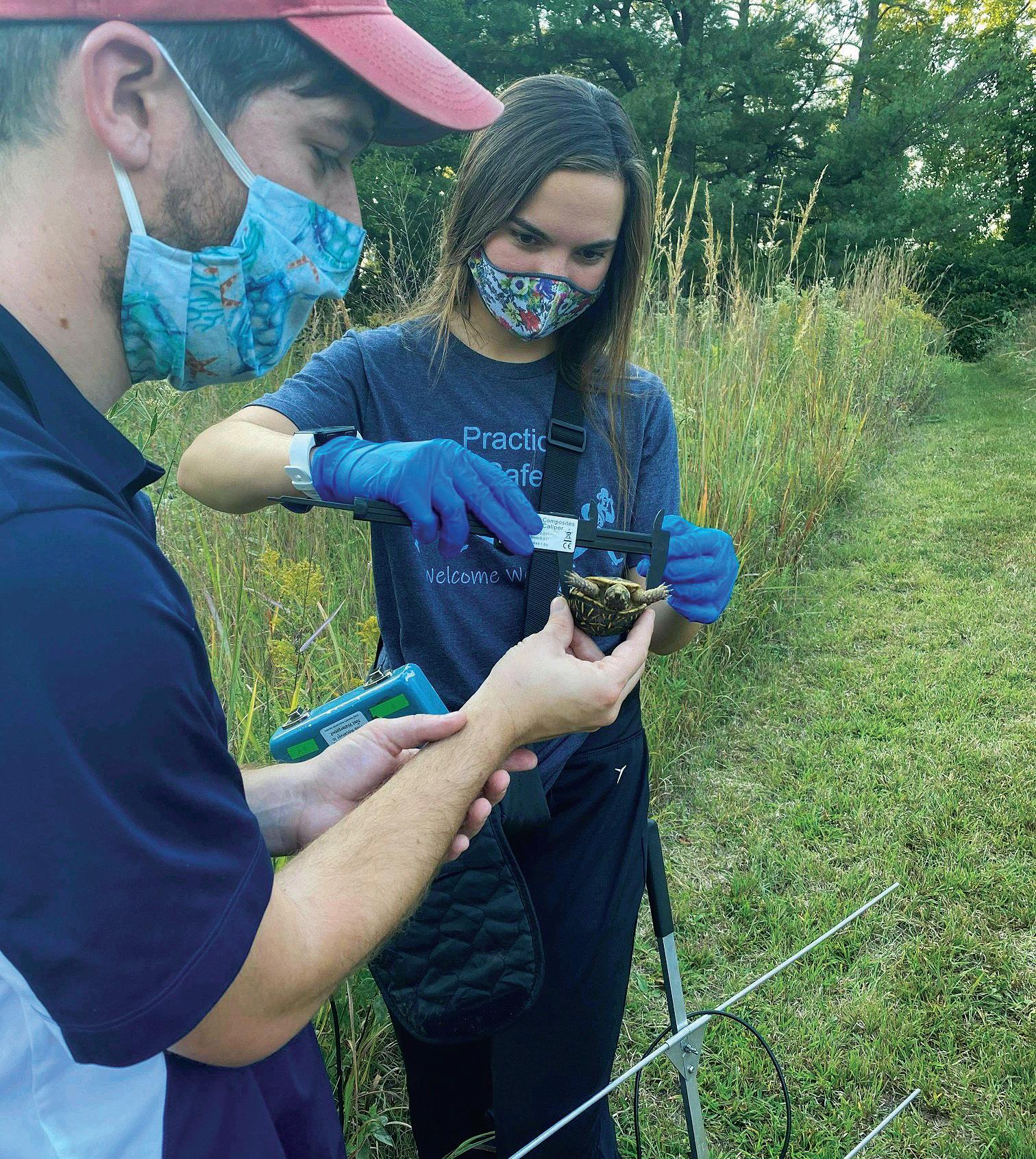




Morgan Hall 209 ∙ 1700 SW College Ave ∙ Topeka, KS 66621
Phone: 785.670.1636 washburn.edu/cas ∙ facebook.com/washburncas
Dean: Laura Stephenson laura.stephenson@washburn.edu
Associate Dean: Matt Arterburn matt.arterburn@washburn.edu
Assistant Dean: Kelly Erby kelly.erby@washburn.edu
Assistant Dean: Tracy Routsong tracy.routsong@washburn.edu
Art: Kelly Thor
Biology: John Mullican
Chemistry: Shaun Schmidt
Communication Studies: Jim Schnoebelen
Computer Information
Sciences: Bruce Mechtly
Education: Cherry Steffen
English: Vanessa Steinroetter
History: Tom Prasch
Kinesiology: Roy Wohl
Mass Media: Maria Stover
Mathematics & Statistics: Sarah Cook
Modern Languages: Miguel Gonzãlez-Abellãs
Music: Craig Treinen
Philosophy & Religious Studies: Ian Smith
Physics & Astronomy: Karen Camarda
Political Science: Bob Beatty
Psychology: Cindy Turk
Sociology & Anthropology: Mary Sundal
Theatre: Sharon Sullivan
Director, Mulvane Art Museum: Connie Gibbons
Directions is a publication for Alumni & Friends
Fall 2020 Vol. 12
Writers, Editors, and Photographers: Monique Robins monique.robins@washburn.edu
Michaela Saunders michaela.saunders@washburn.edu
Kelly Erby kelly.erby@washburn.edu
Contributing Photographers: Lauren Murphy, Doug Stremel
Cover Photo: “Flower Three” by Alyssa Dorn (bfa, ‘20)
Digital art design Washburn Senior Student Art Exhibit 2020
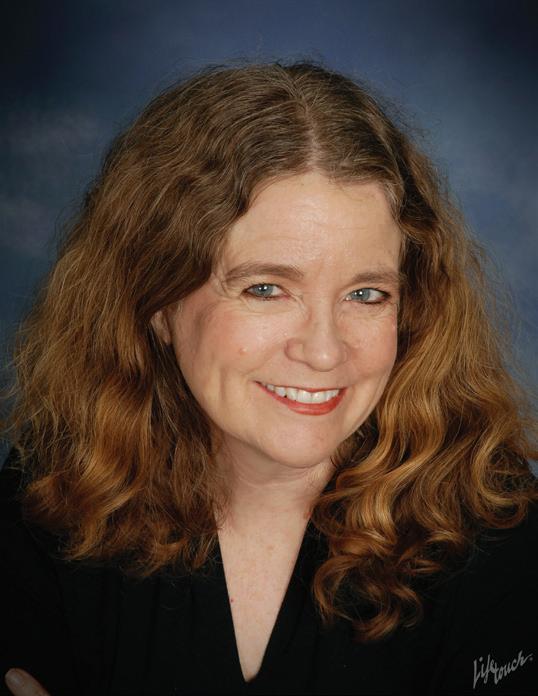
As I write this, we are entering the final weeks of a fall semester unlike any other. The challenges have been daunting. It was only as I started to compose this that I realized how much the artwork on our cover by Alyssa Dorn (bfa ’20) captures my feelings about this semester. A gray world, a hopeful face, and emerging beauty. So much of what is going on in the world seems grim; despite that, the College continues to bloom and offer hope.
The blooms in the artwork remind me of students like the one who told me, as we were discussing the impact of the pandemic on her life, “I’m not going to stand still. I keep focused on my education and what’s next in my life. That’s what keeps me going.” I’m reminded of the achievements of our faculty and students, many of which you can read about in this issue, as they create new academic programs, develope innovative interventions for student success, and take on the problems of our state and beyond.
You can also read about our faculty members’ creativity, flexibility, and perseverance as they have adapted to the challenges of teaching in the time of COVID-19. What keeps us going? Our students. The love of learning and the belief in the transformative power of education. Our hope for the future. And the support of our alumni and friends. Thank you for the many ways you have found to support Washburn and the College during these difficult times.
As we have explored ways to reach our students outside of the classroom, we have also found ways to bring our campus activities to you. You can now view our theatre productions, our music events, art from the collections of the Mulvane Art Museum and senior exhibitions, and various lectures and panels online. The easiest way to follow these activities is through our Facebook and Instagram pages:
https://www.facebook.com/washburncas
https://www.instagram.com/washburn.cas
Stay healthy, continue to find hope, and bloom.

Laura A. Stephenson, Dean of the College of Arts and Sciences
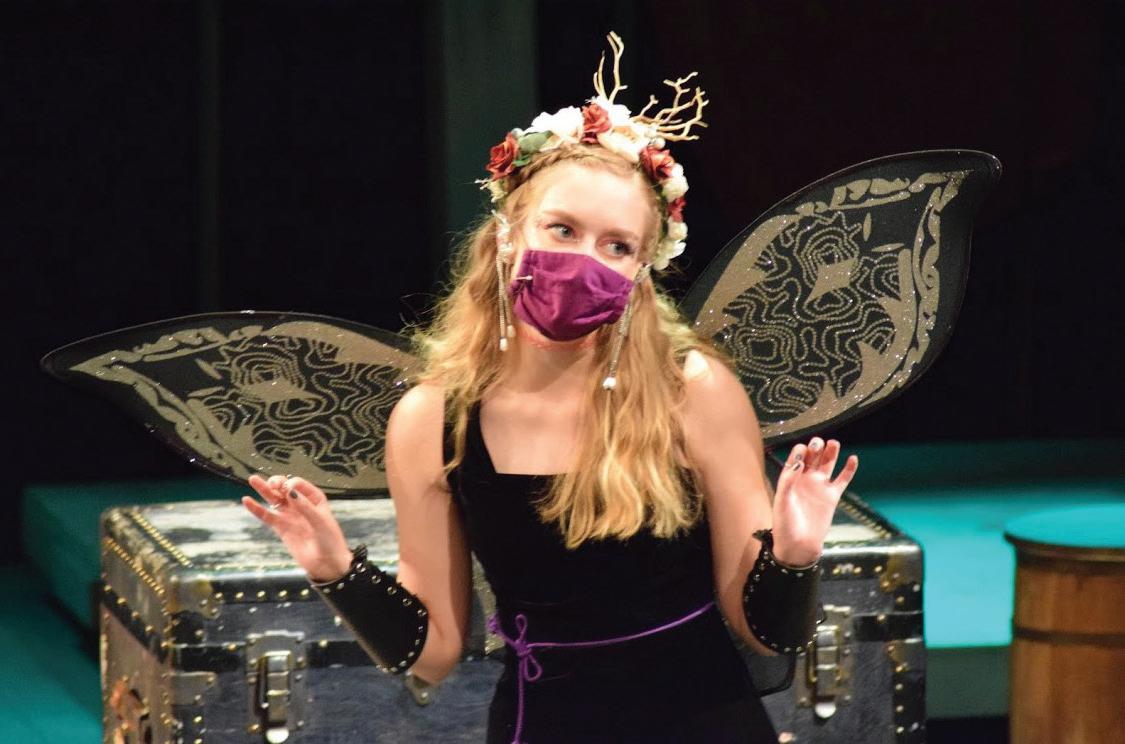
The COVID-19 pandemic created unique teaching challenges as well as new opportunities for College of Arts and Sciences faculty and the students they teach. The emergency shift to remote learning in the spring took everyone by surprise. Over the summer, however, faculty members worked hard to plan their fall courses to accommodate the unique new teaching environment.
“We normally have a total of 25-50 instructors in the 5-10 summer pedagogy workshops we host,” said Melanie Burdick, Director of Washburn’s Center for Teaching Excellence and Learning (C-TEL). “In summer 2020, 214 Washburn faculty came to 68 C-TEL workshops. They stretched themselves out of their teaching comfort zones to learn new approaches and put student needs first.”
Due to the pandemic, classes this year are being taught in a variety of different instructional methods or “course modalities.” For example, some courses meet entirely virtually (using Zoom or a similar platform) instead of in a campus classroom, while others meet face-to-face in socially distanced spaces with desks six feet apart and masks required. Some are taught completely online and students schedule their own classwork time, while still others have incorporated elements of several different modalities. (See graphic, upper right.)
Teaching and learning over Zoom or while wearing a mask and staying six feet apart can feel strange and isolating. “Our faculty are experts in reading their audience,” said Burdick. That skill allows them to see how students are processing course content, who is confused or may need more help learning a concept. Those visual cues can be less clear over Zoom or when students are wearing masks. To make up for this, some faculty are utilizing technology such as electronic polling and the chat feature of Zoom to check for student comprehension and engagement.
“Building rapport is vital.”
– Danielle Head
Building classroom community is also essential to successful teaching and learning, even more so during the
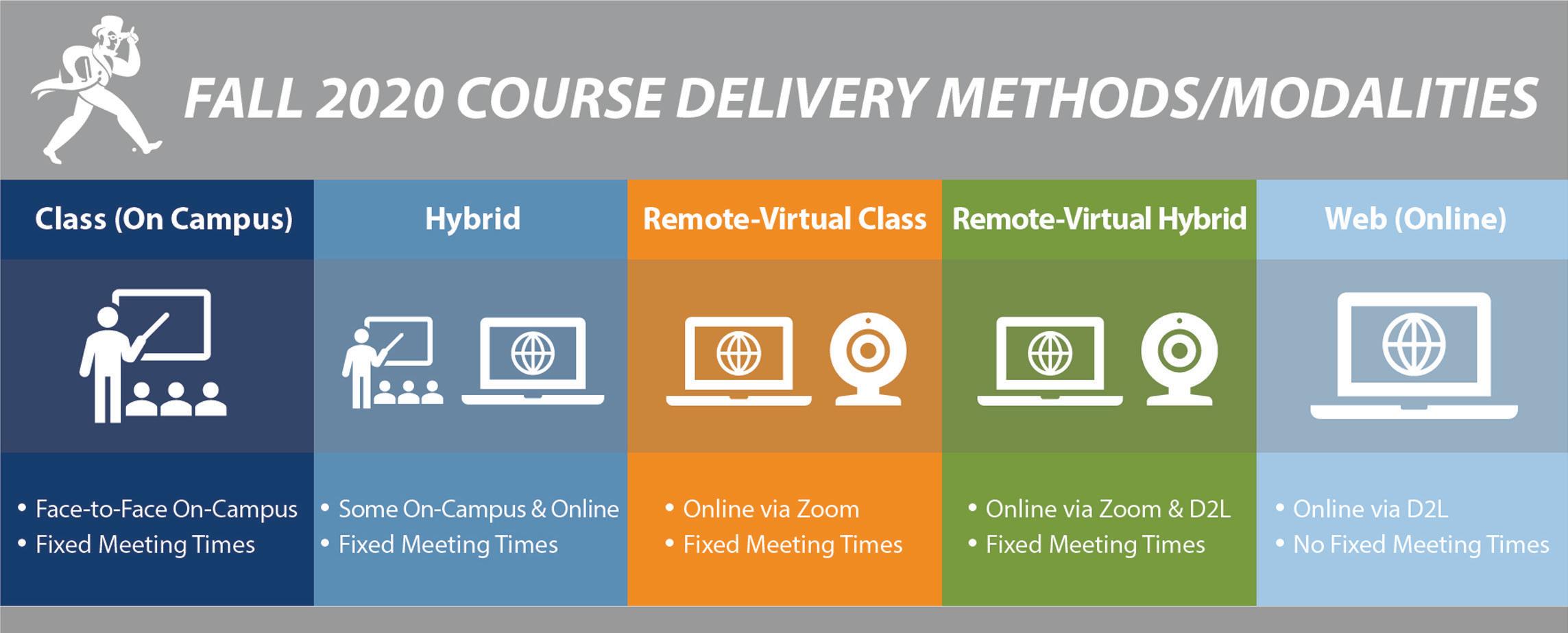
pandemic. To build this community during COVID-19, Lindsey Ibañez, Assistant Professor of Sociology, shared several short video introductions of herself at the beginning of the semester so students in her online class could get to know her. She encouraged her students to also post short videos of themselves to help build rapport and community. Some faculty are also holding virtual student office hours and scheduling one-on-one check-ins with students throughout the semester, despite the extra time that entails. “We’ve always been student-focused,” said Burdick, “but that means something different now, it requires a new level of understanding of each student as an individual learner.” Faculty also remain committed to active learning strategies such as small-group discussion and collaborative learning. To do this while teaching remotely, many faculty are making regular use of a feature in Zoom that allows groups of students to “break out” into their own virtual meeting rooms during larger class Zoom meetings. “This gives students a chance to connect and learn together,” said Michael McGuire, Associate Professor in Psychology. “This is vital to how they digest the material and also to student engagement and well-being overall.” McGuire said he also appreciates technology and apps that allow students to collaborate on files in real time, such as shared documents and spreadsheets.
“We not only need to be creative, but adaptive.”
– Kwok-Pong Tso
AnnaBelle Withington, art major, said she has been very impressed with how teachers have transformed their teaching during the pandemic. “The faculty, everyone on campus, has made it a semester worth my time and money. I’m so glad I didn’t take the semester off. It’s been a really good lesson in adapting and changing,” said Withington.
“What we do every day is solve problems; we’ll figure it out. We’ll keep figuring it out.” – Sharon Sullivan
While every department faces challenges during COVID-19, the obstacles for the creative and performing arts are exceptional. “The thing that’s special about theatre is its liveness,” said Sharon Sullivan, Chair of the Theatre Department. During COVID-19, theatre faculty have revised assignments to include more monologues, and have held classes outside on nice fall days to allow for greater social distancing.
In the Music Department, understanding the science of how the virus spreads has been paramount, as different musical instruments have markedly different profiles of aerosol disbursement, a primary factor in COVID-19 transmission. Practicing a string instrument, for example, produces far fewer respiratory droplets than playing the tuba or singing. Music Department faculty carefully researched the profiles of each instrument and adjusted all practices, individual lessons, and performances accordingly.
“You don’t have to be in a classroom to legitimize learning — or teaching.”
- Danielle Head
Some surprise benefits have come from the increased online activity. Craig Treinen, Chair of the Music Department, said his faculty are exploring hosting international musicians through Zoom. Treinen also said the need to hold auditions virtually resulted in an increase in applicants for Music Department scholarships this year as more students from farther away were able to apply. “Students who may not have been able to make the trip to campus even during a normal year were able to audition virtually,” he said.
Sullivan concurred that the Theatre Department’s fall production, She Kills Monsters, had far more auditions than normal and included many new faces. “People are craving interaction,” she said. She also noted that when they can get the copyright licenses
to do so, streaming performances of their productions “opens up audiences for us worldwide.”
Additionally, because much course content is now recorded and posted online, many students have said they appreciate the greater accessibility of study materials. “I miss campus, but I like the fact that we can access so much from Zoom, D2L, or Whiteboard,” said Tierney Kester, a triple-major in philosophy, anthropology, and criminal justice. “If I have to miss class I don’t miss content. That’s my favorite part, having that extra study tool.” Many students also appreciated the ability to attend classes via Zoom as needed if they couldn’t get to campus.
“I’m so proud of our students. I see them wearing masks, taking care of each other. They choose to be here. They want to be here.” –
Students have also put considerable effort into maintaining safe practices to minimize outbreaks on the Washburn campus. “Our student body is trying just as hard as the faculty to make this work,” said Kwok-Pong Tso, Assistant Professor in the Art Department. “The students have benefitted by being able to be part of the solution.”
Faculty expressed gratitude to the students for their efforts academically and in terms of safety. “Our students are amazing,” said Sullivan. “All in. As always. They are committed, patient, and
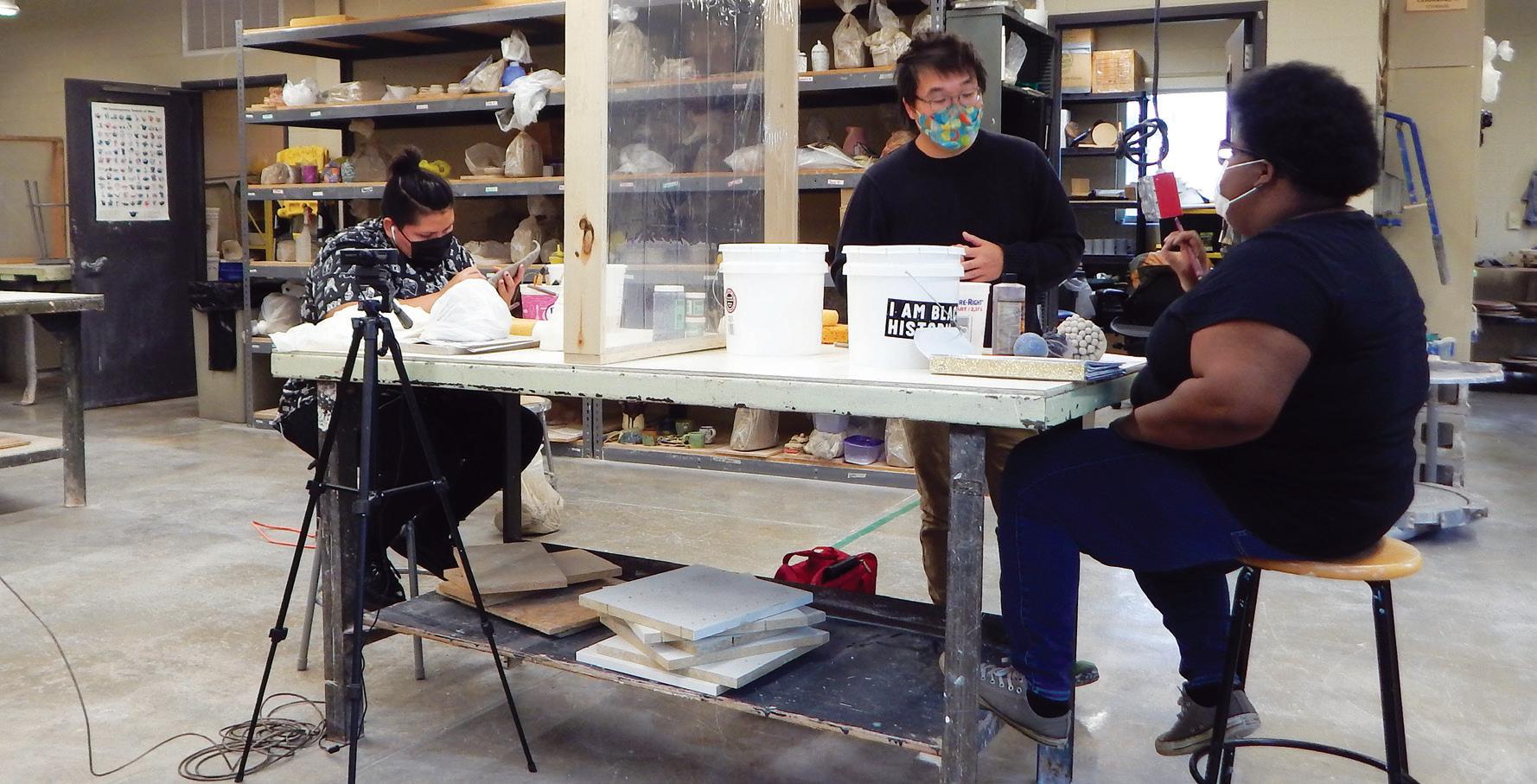
hard-working.” Sullivan, like other faculty, said the students on campus very much want to be here and felt fortunate to get to stay. Ibañez said she was apprehensive about returning in the fall and wanted to be mindful of the risks. However, she has been “blown away by the enthusiasm. The students wanted to come back, and they’ve been terrific about following COVID rules to the letter.”
When asked about possible long-term changes from this fall, Ibañez said, “the reality is, students have always gotten sick, had chronic illnesses, family issues, and jobs. The difference is that COVID is happening to everyone at the same time and has made us more cognizant of how vital it is to be aware of our students’ lives. That should be a legacy of COVID.”



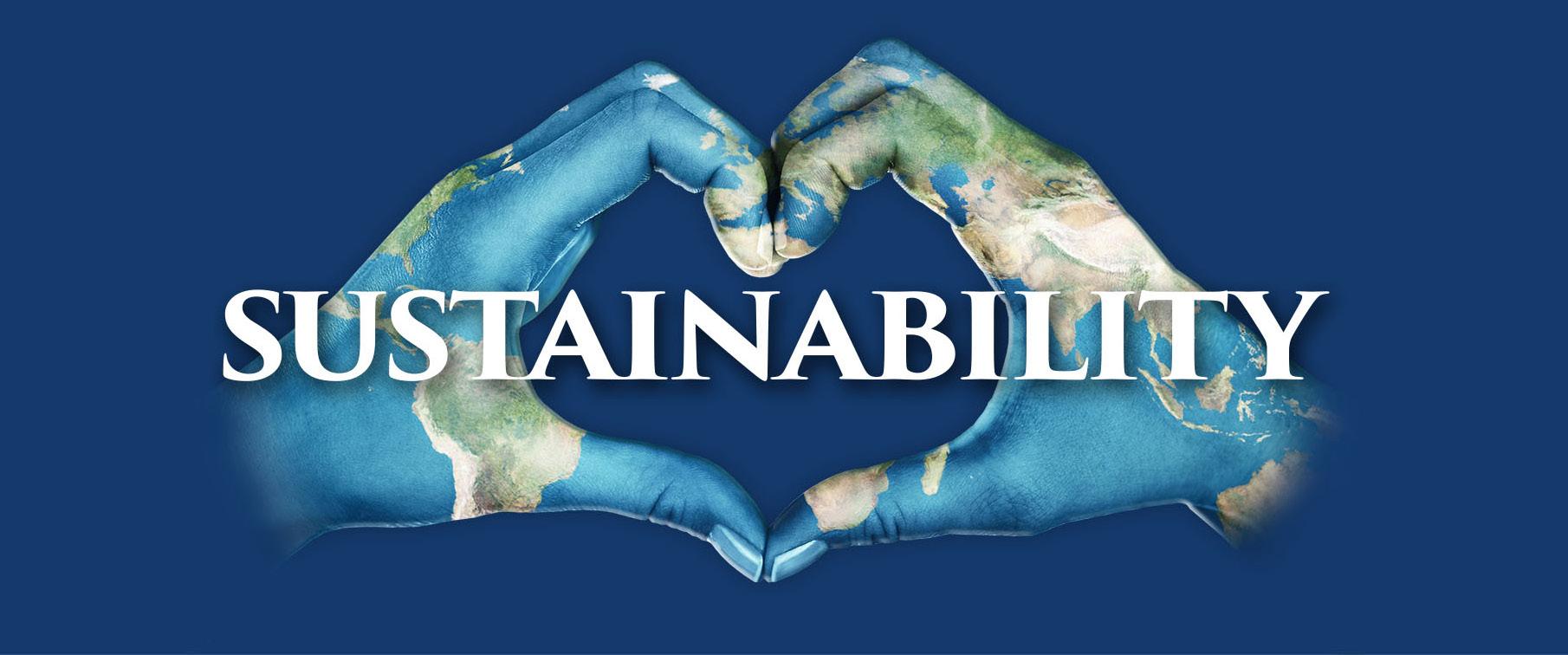

For the third spring in a row Washburn will engage in a collective, interdisciplinary learning experience known as WUmester. The goal of the program is to engage the entire WU community in a cross-disciplinary learning experience on timely subjects and help students see the connections between the subjects they study in the classroom and real-world debates and problems.
Through specialized classes, co-curricular programing, and activities, Washburn will explore sustainability in nuanced ways. As envisioned by the organizing committee, “WUmester will consider sustainable and unsustainable lifeways across cultures and throughout history in order to expand and complicate our ideas of what sustainability means, and why it is vitally important in the 21st century. Ultimately, it will support Washburn’s goal of promoting productive and responsible citizenship by encouraging members of our community to cultivate more sustainable ways of living together.”
Programing will include many virtual events as well as art installations at the Mulvane Art Museum and personal sustainability challenges, such as cutting back on plastic straws. Visit washburn.edu/wumester for program updates and ways to get involved.
February 10, 12:00 PM - Approaches and Arguments for Sustainable Practices: A Panel Discussion - Panelists include Dr. Kellis Bayless (WU Biology Department), Leilani Grey (Program Assistant at the Climate + Energy Project and representative of the City of Topeka Sustainability Advisory Board), Zack Pistora (Legislative Director and Lobbyist for the Kansas Chapter of the Sierra Club), and Dr. Ian Smith (WU Philosophy and Religious Studies Department).
February 18 - Harriet A. Washington will speak related to her book A Terrible Thing to Waste: Environmental Racism and its Assault on the American Mind. The presentation will be viewable at youtube.com/WashburnVideo.
April 1 – Panel discussion featuring Environment Missouri
April 10, 17, 24 – Explore the Downtown Topeka Farmers Market
April 22 – Earth Day commemoration
April 22-24 – WIFI Film Festival, online. Learn more at wififilmfestival.com.
May 1 – Explore the Downtown Topeka Farmers Market
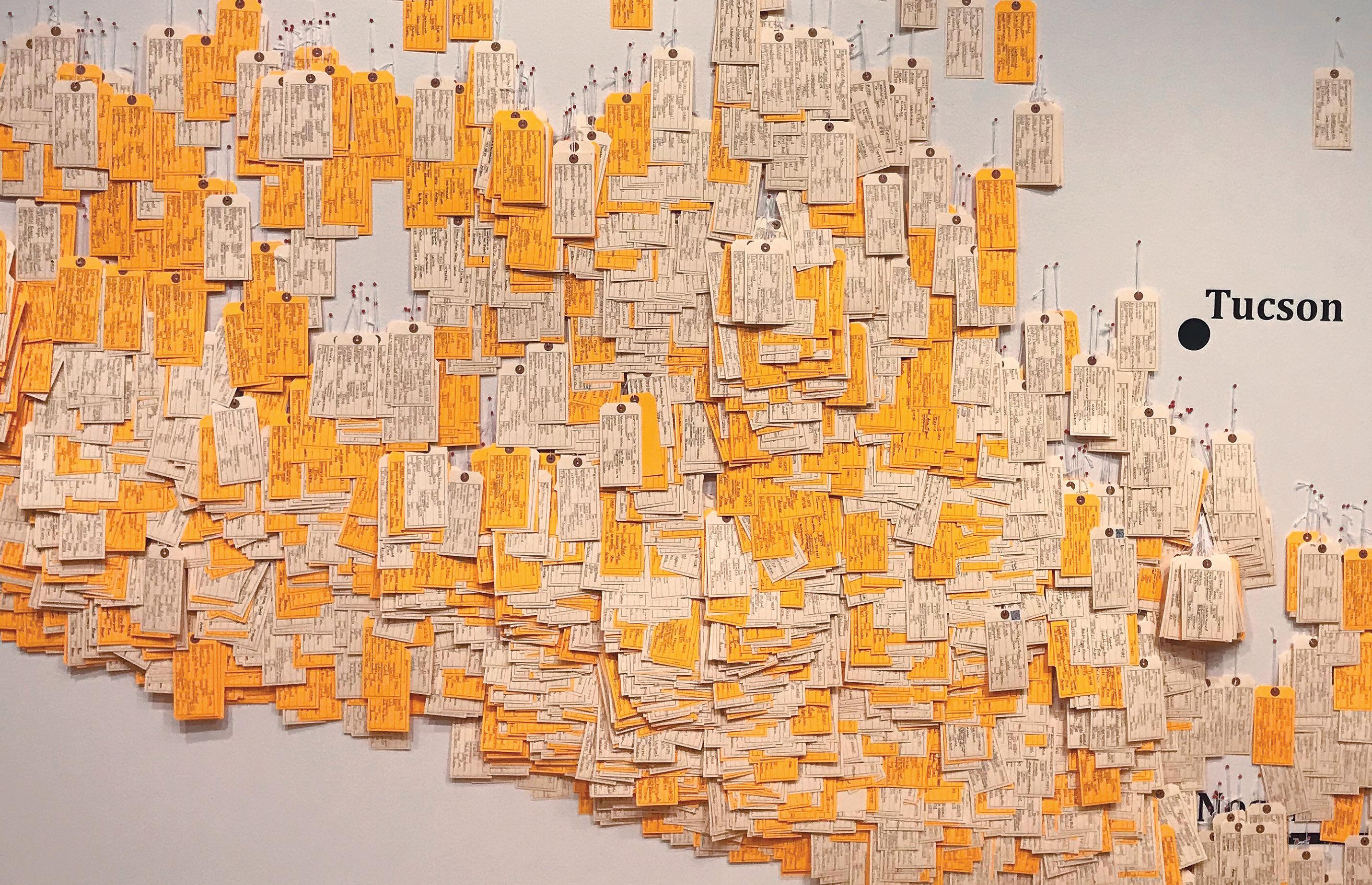
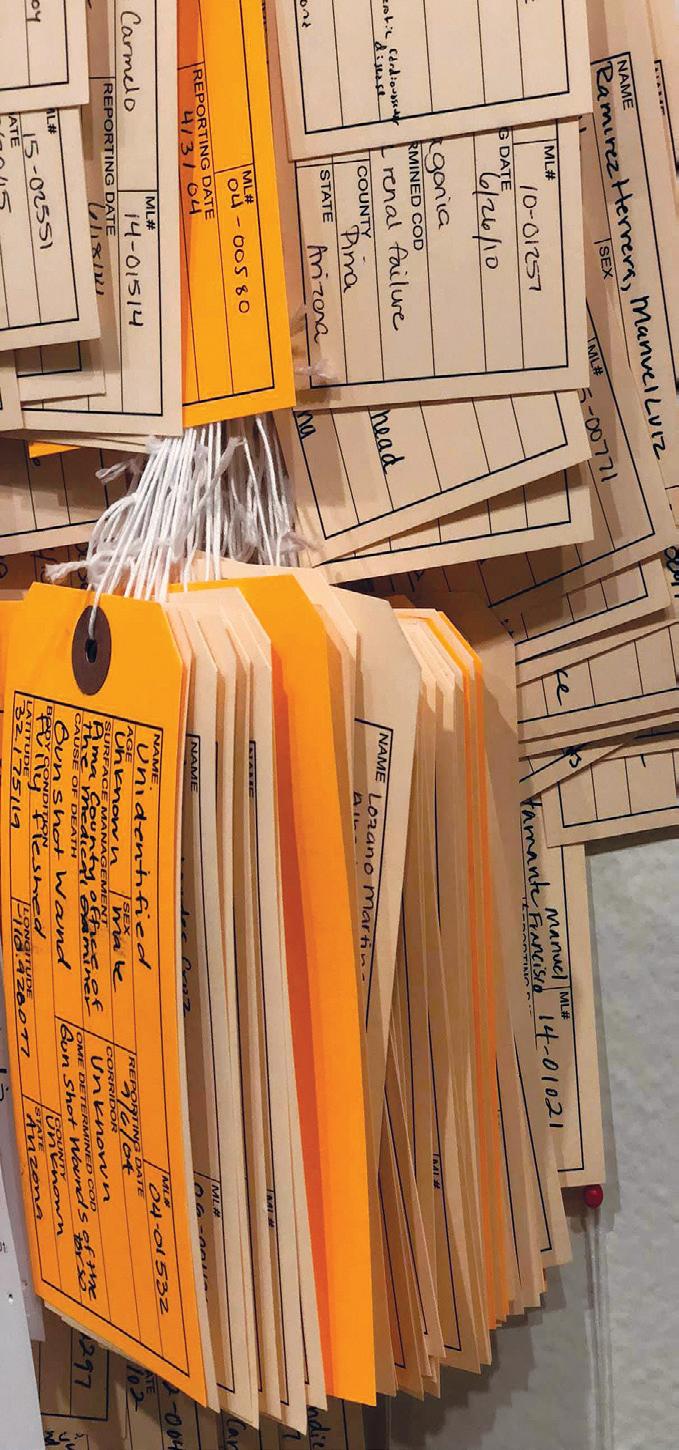
Art has the power to engage, to explain, and to compel.
That power drove Jason Miller, Assistant Professor of anthropology, and Connie Gibbons, Director of the Mulvane Art Museum, to seek an opportunity to host a global, participatory art installation intended to draw attention to how a set of U.S. immigration policies begun in 1994 has led to the deaths of thousands of migrants at the southern border.
“Now, 26 years later, the policy still doesn’t work and people are still dying. What does that say about us and what we want to be as a society?” said Miller, who teaches a course on the Immigrant Experience in the United States. “It really makes us ask questions about immigration policy.”
The brainchild of the nonprofit Undocumented Migration Project, the Hostile Terrain 94 installation includes a wall map of a portion the Sonoran Desert. Geolocated on that map are approximately 3,200 toe tags showing the exact location where human remains have been recovered in these borderlands of Arizona and Mexico since 1994, when the U.S. Border Patrol began enforcement of “Prevention Through Deterrence,” policies intended to deter the illegal
crossing of the southern border. Orange tags – there are approximately 1,000 – represent the location of recovered remains of unidentifiable individuals. Manila tags represent the remains of those who have been identified.
“It’s humbling to see it up on the wall,” Miller said. “There is one spot on the map, for example, that requires three different pins to secure 60 separate toe tags. They all died in the same place. And these are just the people who were recovered.”
The exhibit will take place at many different institutions, including 25 international sites in 15 countries and 94 locations in the United States. At each exhibit location, the toe tags are completed by members of the local community. In Washburn’s case, tag writers included students, faculty and staff from Washburn, and many community members.
The goal of the exhibit and related virtual programming organized by a committee, Miller said, is to help each visitor understand immigration as “something we all have a stake in. Immigration policy isn’t this thing that happens in Washington D.C. that we’re disconnected from. Here in Kansas, immigration policy effects all of us.”
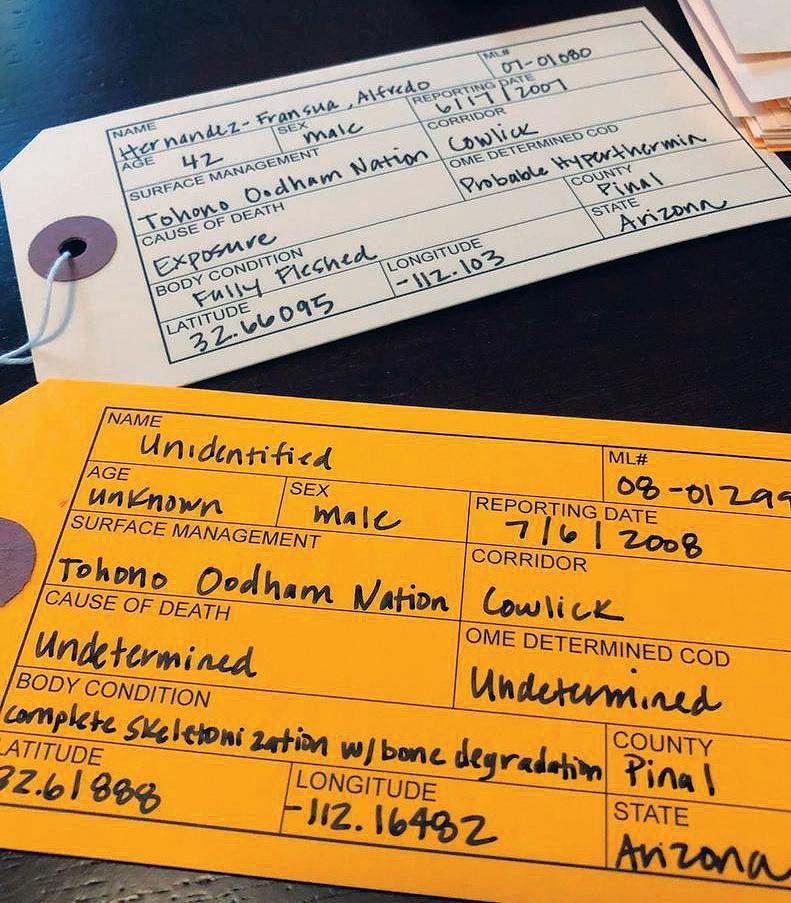
Hostile Terrain 94 will remain at the Mulvane through the end of November. Because of the COVID-19 pandemic, the exhibit of Brian Lanker portraits, I Dream a World: Portraits of Black Women who Changed America continues as well. Gibbons said the chance to see Hostile Terrain
and I
a World during the same visit is fitting for current times.
“It all ties together,” she said. “The conversation is related.”
Due to COVID-19, visits to the Mulvane Art Museum are by appointment only. Learn more and engage in related virtual programming by visiting www.washburn.edu/hostileterrain.

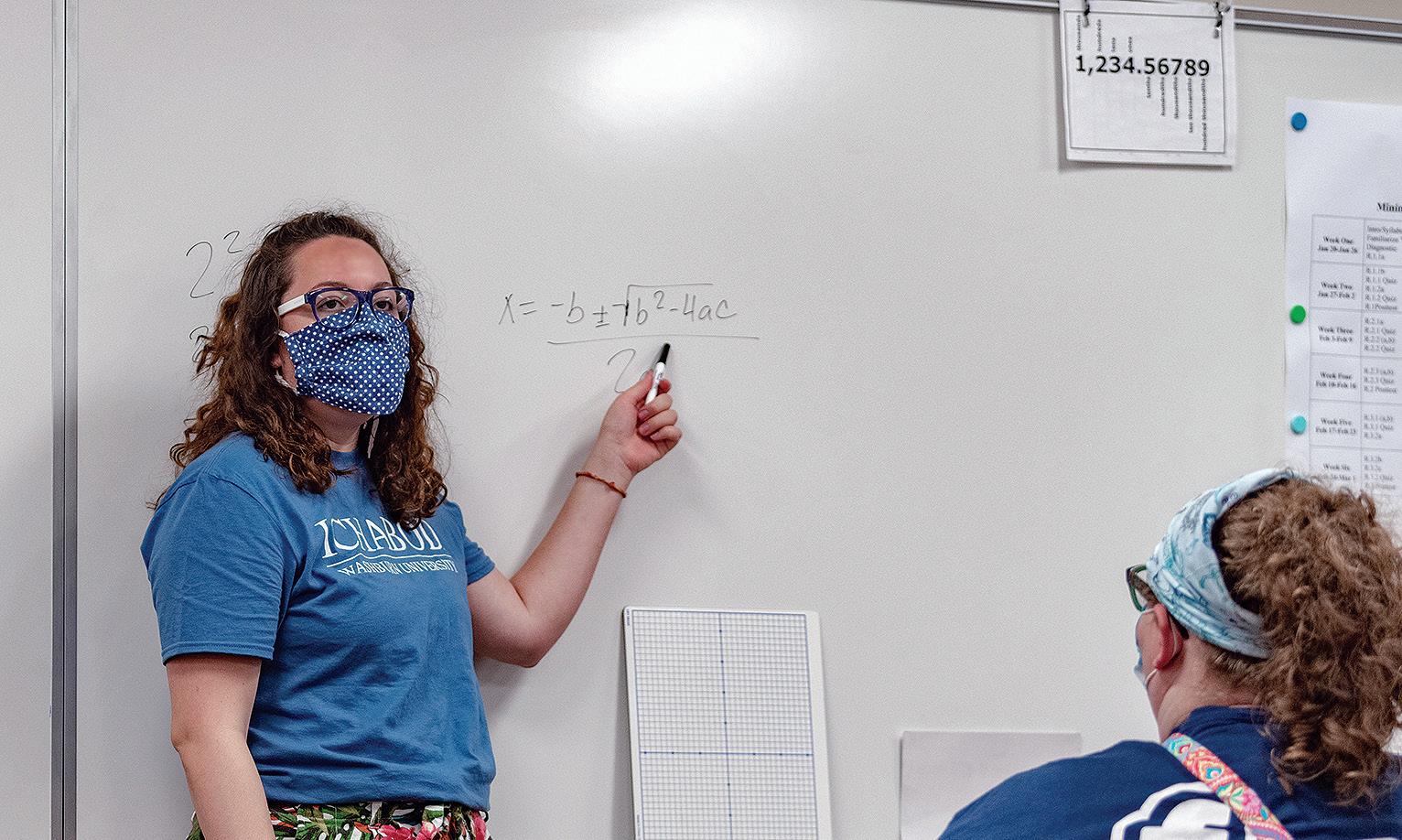
New national trends in math education demonstrate that individualized instruction while students are actively engaged in solving math problems improves students’ success and can eliminate the need for remedial math courses. Thanks to generous donors, a federal grant, and support from the Center for Student Success, the College of Arts and Sciences implemented new math programming during the 2019-2020 academic year. Critical to this program is the newly opened John and Barbara Stauffer Learning Center in Mabee Library, which offers Washburn students this kind of personalized teaching through the Dr. Richard E. Shermoen Math Lab. The results surpassed all expectations.
Over the past several years, Washburn’s Math Department has been reimagining math pathways to best serve students. While emphasiziing more individualized instruction, faculty across campus considered how math curricula would best fit student career aspirations. College Algebra is historically a standard requirement for all degrees, however, many of today’s graduates are better served by courses emphasizing broader quantitative reasoning. College Algebra is still essential for natural sciences and business majors, but has been replaced in many other Washburn degrees by Contemporary
College Math, which is geared toward tangible, real-world applications of math such as personal finance, analyzing data, and determining probabilities.
Solid math skills are essential for the professional and academic development of students, but many experience great challenges in these courses, and abundant data have shown students who struggle to complete math courses have a much lower chance of graduating. Under Washburn’s previous math curriculum, students needing math support were placed in
preparatory courses that did not count toward their degree, and it could take up to three semesters to complete their math course sequence. In the new model, students have multiple preparatory options, including co-requisite “just-in-time” lessons that get them up to speed quickly and empower them to complete the collegelevel work in a single semester.
A major innovation is diagnostic testing software, which identifies specific concepts on which new students need improvement. “We get to laser-focus on what each student needs,” Math Coach/Lecturer Lori Gill said, “whether that’s brushing up on a single skill or learning everything from the ground up.”
“They were able to make sure I could reach my highest potential via the method that came most naturally to me.”
- EngSean Lee, junior
Computerized math modules now allow students to work at their own pace and receive immediate feedback. However, a major component of the Math Lab’s success is the availability of math coaches and tutors who provide personal attention to students during drop-in hours. “I didn’t initially feel [learning] on a computer was going to be right for me,” said junior EngSean Lee. “But the amount of support through the Math Lab is incredible.”
Lee, who initially enrolled at Washburn in 2015, said he had always struggled with math classes and cited those struggles as a major reason he chose to stop attending college. He re-enrolled in fall 2019 and was placed into a preparatory math course. “I was nervous,” said Lee. “But I passed that class with an A. I think that speaks volumes about how dedicated they are to their students.”
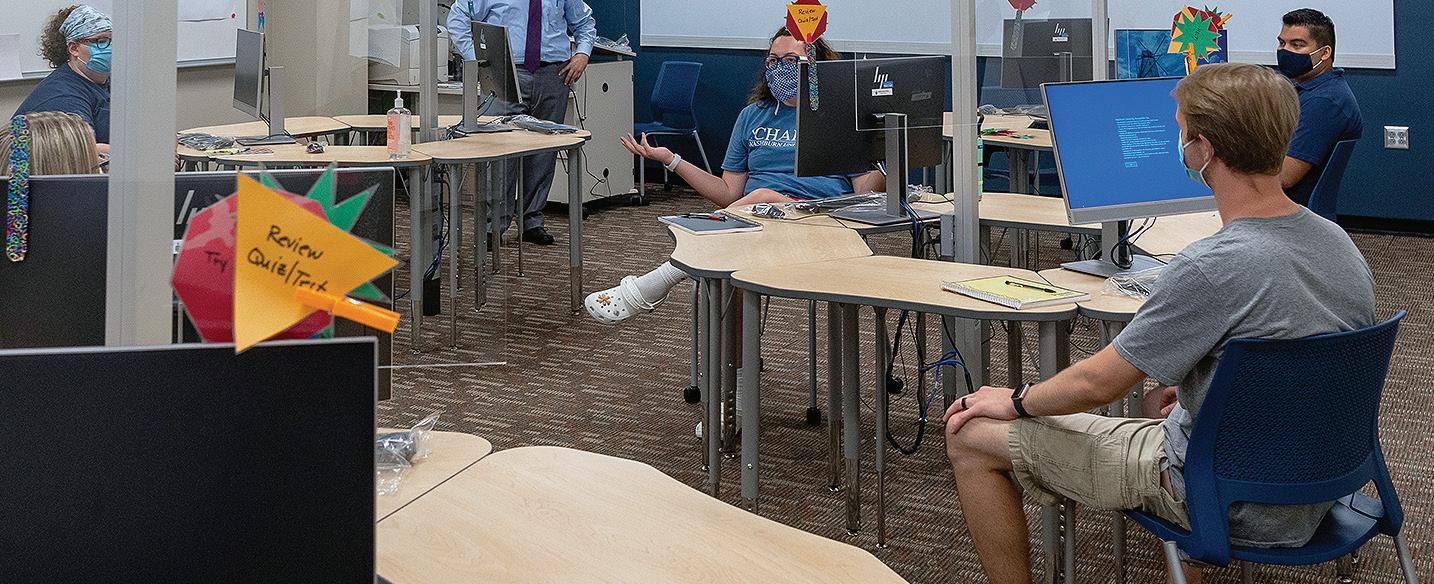
Fear of math and self-doubt can be major issues for students, and placement into developmental courses can itself erode confidence. Like Lee, many students come to the Math Learning Lab after years of struggle in math classes, convinced they “can’t do” math. Math Learning Lab Manager Dave Snyder says it is not uncommon for students to come to the Math lab burdened by the “math trauma” they’ve accumulated in previous classes. With the resources available through the new system, Snyder and Gill help those students realize they are capable of successfully learning the material. Gill has recognized a number of students who failed her previous preparatory algebra courses but have thrived in the new program.
Innovating the fundamental math curriculum and improving support systems for students was a weighty task for Washburn’s Math Department. Tremendous planning and effort were needed to integrate the software to support new co-requisite curricula and placement methods. In addition to Snyder and Gill, many faculty made major contributions to the project, most notably Dr. Kevin Charlwood, Dr. Sarah Cook, and Mr. Todd Cooksey.
That hard work has already produced extraordinary outcomes for Washburn students. During the 2017-2018 academic year, 56% of students taking fundamental math courses achieved the university requirement of a C or better, but in the 2019-2020 pilot year of the new math program, 74% of students taking those courses were able to do so.
“When we proposed the new plan, we set what we thought was a lofty goal of achieving 70% student success in the new Fundamental Math Program after the first two years,” said Matt Arterburn, Associate Dean of the College of Arts and Sciences. “We managed to exceed that goal within the first year and did so despite the disruptions caused by COVID-19. That’s really something to celebrate.”
Thanks to the bold initiatives of the new Fundamental Math Program and the Math Learning Lab, Washburn is helping students conquer their fear of math and acquire the quantitative skills they need for their academic and professional success. “It’s honestly been a blessing,” said Lee.
You can view the Washburn University Alumni Association and Foundation’s video article about the Math Learning Lab at bit.ly/WashburnMathLab.
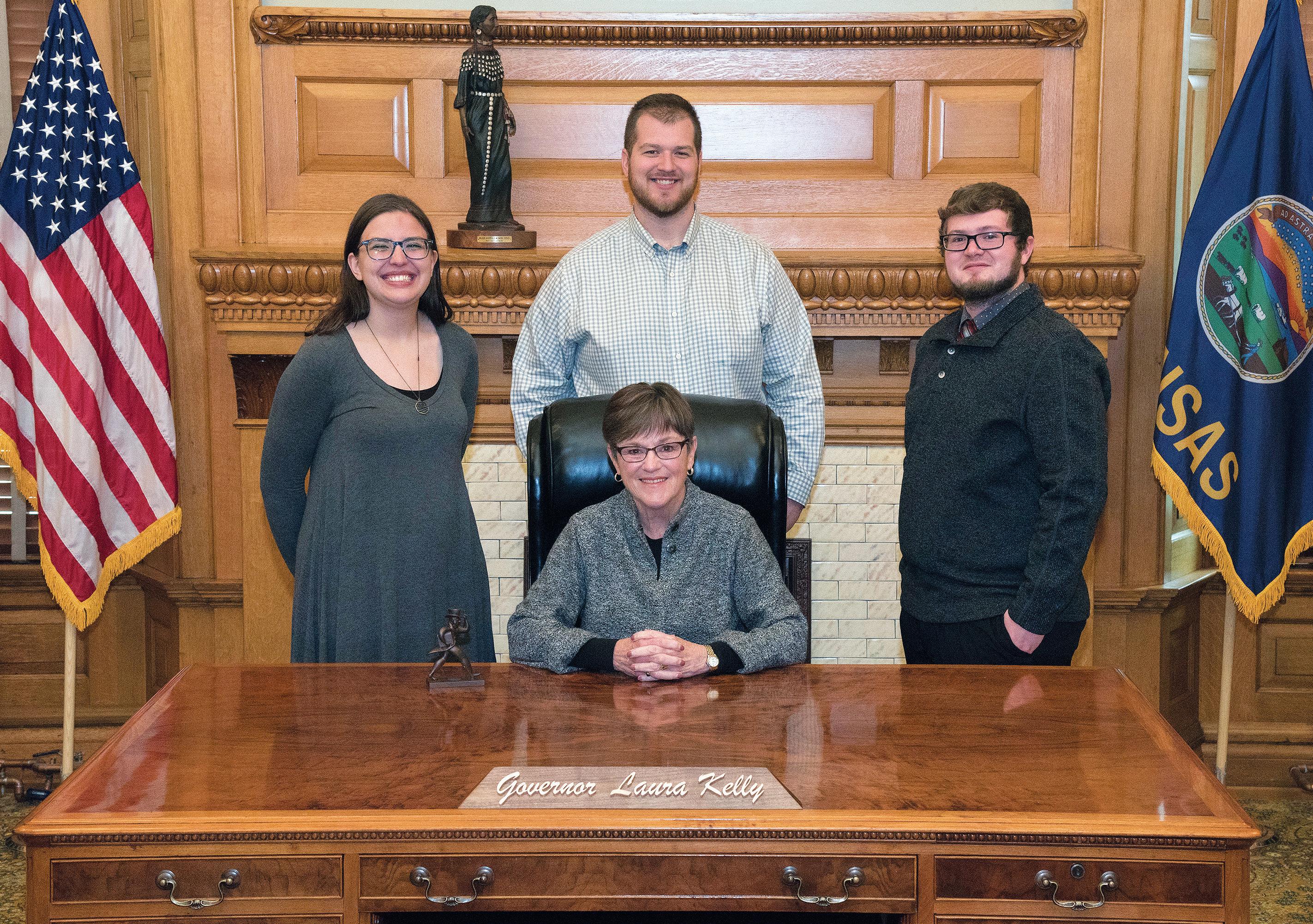
From political campaigns to the Governor’s COVID-19 recovery office, Washburn Political Science students are putting their skills to work.
Within the College of Arts and Sciences, 14 of the 19 academic departments require an internship, mentored capstone project, or field work for credit. One of those departments, Political Science, offers a variety of such opportunities. Those include specialty courses on the Iowa Caucus and the UK’s House of Commons, and internships in the Kansas legislature and government offices. Some students complete more than one such endeavor.
Cassidy Precht (left) and Jake Regnier (center), both interns in the Office of Constituent Services, pose with office director Garrett Rogers (ba ‘19) and Governor Laura Kelly. After his internship, Regnier was hired full-time, and currently works in the Governor’s Office of Constituent Services.
Bob Beatty, Chair of the Department of Political Science, said the department’s internship placement has grown from about 2-3 interns placed in the 1990s to 20-25 per year currently. The department organizes a legislative intern program open to all majors. Being in Topeka helps Washburn students continue on with internships in other government offices or as new professionals.
“It’s been such a great opportunity to work and adapt,” said Jillian Roy, a senior in political science who began an internship with the Governor’s COVID-19 Recovery Office this summer.
Roy is applying to law schools now and using the experience as the basis for her personal statement. Working in the office responsible for CARES Act management is bringing to life things she learned in Public Budgeting and many other classes, growing her confidence and giving her opportunities to use her skills.
“Having something to talk about, to put on a resume, and more job experience -- all of these opportunities I’ve been fortunate enough to have with the department,” she said.
The Department recognizes unpaid internships can be a burden for students. That’s where unique scholarship opportunities come in. “We do worry that students can’t take advantage of internships because they’re working a part time job,” Beatty said. “It’s hard to do if they are working a job, and they need money for tuition or housing.” The Clyde Hill Endowed Scholarship and the Don and Carol Kissinger Scholarship Fund provide stipends to political science students who couldn’t otherwise take an unpaid internship. “The stipends can make it possible,” Beatty said. “That’s been the rocket booster of the last few years. It’s wonderful.”
The Clyde Hill Scholarship made the difference for Adam Young, who worked in the Governor’s Office of Constituent Services. Originally from Winfield, he transferred to Washburn and learned of the internship and stipend after about nine weeks on campus.
“Dr. Beatty helping me to get my foot in the door was the biggest thing,” said Young. “Dr. Beatty really models for me consistency and decency. He prepared us really well; he said, ‘show up every day and wear a necktie.’ He gave us guidelines to be successful.”
Being able to see the connections between what you have learned and can do and the career you seek was a breakthrough for Melissa King, who graduates in December and now realizes she can pursue her goals without leaving Kansas. King, a double major in political science and mass media, public relations emphasis, said her work as an intern with Governor Kelly’s Office of Appointments gave her the chance to take on more responsibility over time. She also interned on the governor’s campaign. “It definitely gave me more of an insight to all the opportunities in Kansas. It really opened up a lot of doors,” she said. “It has expanded my horizons.”

In response to student desire for more courses focused on Black history and the nature of diasporic peoples and identities, the College of Arts and Sciences has created a new interdisciplinary minor program in African American and African Diaspora Studies (AAADS).
A team of faculty, staff, and students who serve on Washburn’s Academic Diversity and Inclusion Committee came together to propose this program, which launched in the fall. This timing, following months of national and international demonstrations and civil discourse about racial inequality and systemic discrimination, is significant.
The new program includes some classes that have been taught previously. For example, “Peoples and Cultures of Africa,” a class offered by Mary Sundal, Professor of anthropology and Chair of the Sociology and Anthropology Department, already fulfilled the student learning outcomes of the AAADS program. However, Sundal has now added content to the course to underscore the nature of diasporas in order to further align it with the program’s goals. Courses on African American history, the Civil Rights movement, and the sociology of race and ethnic relations are also part of the minor.
In addition, the AAADS program includes a new course called “Introduction to Critical Race and Ethnic Studies” that will anc the minor plan of study and count as general education credit to encourage students in all majors to include it in their course work as well.
“This new course will provide students with foundational knowledge to understand race and ethnicity as socially, culturally, and historically constructed realities that sustain unequal distribution of political and socioeconomic power and inform constructions of identity and community,” explained Sundal.
Sundal serves as the initial director of the program. She is hopeful the minor will encourage faculty members to develop new courses grounded in the perspective of Africa and the African diaspora that prepare students to work toward an anti-racist and socially just world. She also hopes the program will help Washburn’s increasingly diverse body of students feel more represented and at home in Washburn’s curricula.

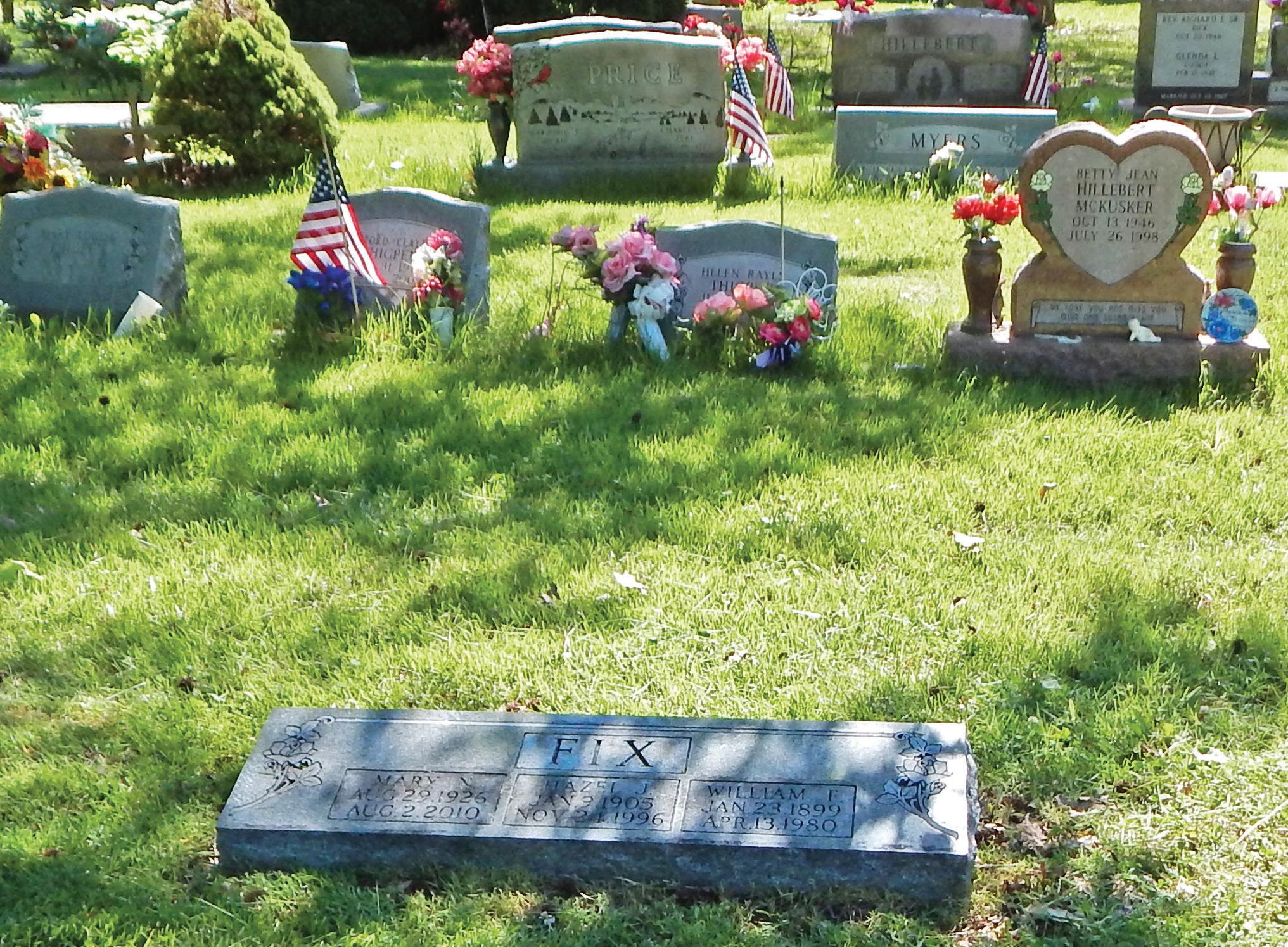
On page 10 of the 2016-2017 issue of Directions, we shared the remarkable story of Mary N. Fix (ba chemistry ‘49), and this year we are happy to make an addition to her tale.
Ms. Fix was able to attend Washburn and pursue her dream of studying chemistry because of a scholarship. After graduation, she went on to pursue a career in physics culminating in her work at the Sandia Labs in Albuquerque, NM where she was the only female physicist. When she passed away, she left her estate to Washburn to support students, and the Mary N. Fix Natural Sciences Scholarship continues her legacy.
Although she was buried with her parents in north Topeka, Ms. Fix had no surviving family, and so her tombstone was never engraved with the date of her death. This year the College contacted the cemetery and arranged for the engraving on Ms. Fix’s tombstone to be completed. Mary N. Fix, scientist, trailblazer, and proud Washburn graduate, now rests with her parents under a finished marker. We are pleased to have been able to honor her in this way.

English: Assistant Professor Andy Farkas’s debut novel, The Big Red Herring, made Entropy Magazine’s Best Fiction Books of 2019 list.
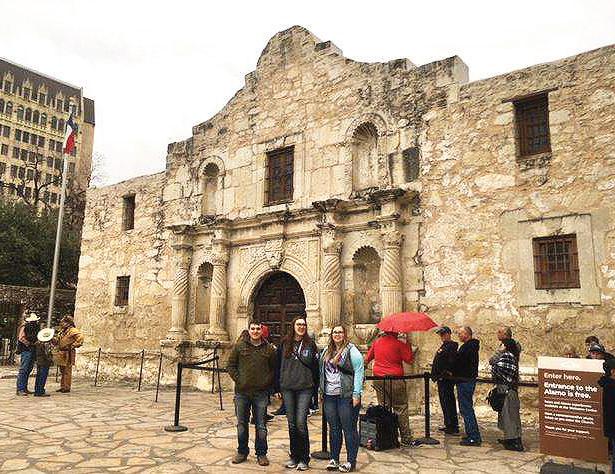
History: In January 2019, Professor Kim Morse travelled with history majors (left to right) Chandler Burrows, Alexis Douglas, and Paige Fryback to present research at the Phi Alpha Theta Biennial Conference in San Antonio, Texas.
Lecturer Dyan Akkouche Greene has taken on the duties of the Catron Visiting Professor this fall. Thanks to Associate Professor Danielle Head, seniors presented their artwork online; visit wuartexhibitions.com to take a look. Art students, staff, and art lovers traveled to Chicago during Spring Break 2020 for the city’s First Friday Art Walk.
Congratulations to Lecturer Erica Jackson, who completed her Ph.D. Dr. Bob Flahart retired from teaching. In late September, Biology Club students and Assistant Professor Ben Reed visited Karlyle Woods, Washburn’s field station, to locate and measure box turtles wearing transmitters. (See photo, inside back cover.) The department mourns the loss of Professor Emeritus Betty Cole, who passed away.
Assistant Professor Allan Ayella published an article in collaboration with Wichita State University in the journal Protein Science entitled “Conserved tryptophan mutation disrupts structure and function of immunoglobulin domain revealing unusual tyrosine fluorescence.” The research was on the structure of a protein involved in pancreatic cancer.
In spite of COVID-19 limitations, the Communication Department was able to hire two new faculty: Lecturer Carson Kay and Lecturer Kai Xu. In only the fifth year of the program, 20 students graduated with master’s degrees in Communication and Leadership. The department thanks its donors for its largest-ever scholarship year; almost a dozen students received over $11,000. Despite the year’s challenges, the debate team added eight new recruits and the Mock Trail team added five.
Five CIS students mentored by Professor Nan Sun had papers accepted by the International Association for Computer Information Systems annual conference in early October. Cian Renner virtually presented “A Study of the Role of VR in Mental Health Based on Public Opinion,” co-authored with Tyler Cross and Daniel Corrales. Dane Vanderbilt and Kun Xie presented “An Applied Study of RNN Models for Predicting Cryptocurrency Prices.” Both papers were published in Issues in Information Systems. The CIS program has added a new concentration in data science, a growing field, to its offerings.
Dr. Sandra Tutwiler and Dr. Judith McConnell-Farmer retired from the department this year. The Middle School STEM (Science, Technology, Engineering, and Math) program was approved by the state and will be accepting students this fall. Professor Emeritus of Education Dan Harden passed away in July. He specialized in education law and philosophy of education and will be missed.
Professor Dennis Etzel Jr. released Two Ponders: a Collaboration (2019) with artist Barbara WatermanPeters and Everything is Ephemera (2020), a tribute to Washburn University. Senior Lecturer Izzy Wasserstein’s story “Requiem Without Sound” was named a notable story by Best American Science Fiction and Fantasy 2020. She was also named the 2020 recipient for the Arty Literary Arts award in Topeka. In the 2019-2020 year, 23 English majors received competitive departmental scholarships totaling over $43,000. In spring 2020, three English majors were named Sibberson Award finalists: Lauren Evans, Abigail Holloway, and Elizabeth Moore. The English Department offers its condolences to the family of their former Administrative Assistant, Ms. Karen Simpson, who passed away this year.
The department played an active role in WUmester programming in 2019, offering many courses and special programming on citizenship and suffrage. Additionally, Assistant Professor Bruce Mactavish was instrumental in bringing both Flonzie Brown-Wright and Koritha Mitchell to campus to give presentations. #WUWillmottWeek, the first-of-its-kind digital film fest organized by the History Department in September 2020, was a success. Events included a Zoom discussion with film maker Kevin Willmott about his recent film, Da 5 Bloods, directed by Spike Lee.
Student Layne Nash received a 2019 SHAPE America National Physical Education Major of the Year award. In summer 2020 the Kinesiology Department had to cease in-person training at their WU Moves Community Wellness Program, so they developed and initiated a remote training/consulting outreach program run by department majors. This program continued through the fall in addition to in-person, one-on-one consulting at the Petro Center facility. The department is proud to announce they are now a Higher Education Partner with Functional Movement Systems, a globally recognized method of movement assessment.
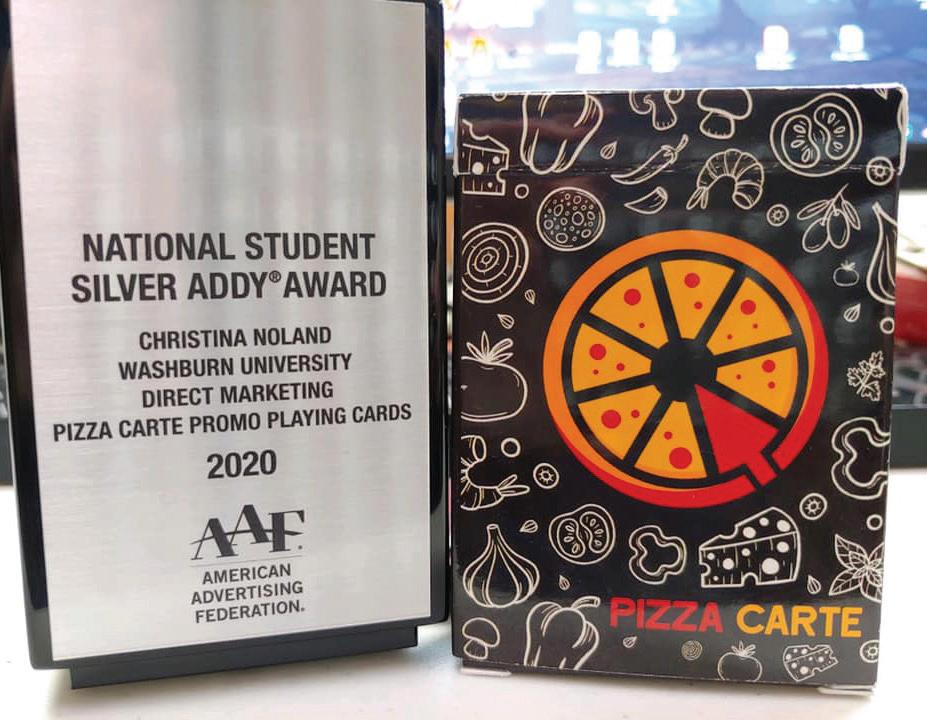
Mass Media: The American Advertising Federation honored Washburn student Christina Noland’s work with a National Student Silver ADDY Award.
Film students Eriko Hiranoi and Drew Dickes, mentored by Lecturer Sam Finch, won first place in the documentary film category in the Kansas Association of Broadcasters contest. WIFI 2020 had to be cancelled, but WIFI will be back in 2021 in a remote format; watch washburn.edu/wifi for details. Both Assistant Professor Andrew Anglin and Assistant Professor Matt Nyquist won Student Life Achieving Excellence Awards in 2019, and Professor and Chair Maria Stover received the Women of Influence Award for 2019 from the Greater Topeka Partnership. Stover and Assistant Professor Kristen Grimmer brought in a Humanities Kansas Grant to support the WIFI Film Festival.
Students Claire Mosier and Jacob Talkin organized the first Midwest Math and Stats Student Conference, held at Northwest Missouri State in February 2020. Dr. Kevin Charlwood retired after a distinguished 23-year career, serving 12 years of these as Department Chair. Lecturer Todd Cooksey developed the curriculum for the new course, Preparation for Quantitative Reasoning Pathway, and the new co-requisite portion of our Contemporary College Mathematics course. (See article, p.14.) Professor Janet Sharp published two chapters in Culture That Counts: A Decade of Depth.
Professor Courtney Sullivan took students to London in February to attend a workshop at King’s College with worldrenowned experts on French film. Senior Lecturer Georgina Tenny took a group of students to the Dominican Republic during Winter Break. Sullivan has an article forthcoming in the journal Contemporary French Civilization Assistant Professor Michael O’Brien is exploring new publishing platforms and wrote a blog for La corónica Commons on relating to students in the new online environment. Professor and Chair Miguel González-Abellás had three book chapters accepted for publication.
Seniors Taylor Molt and Toni Rainey participated in masterclasses with musical theatre expert Tom Burke and opera singer Alan Held. Lecturer Lara Brooks presented at the West Central NATS on Jazz Voice for Classical Singers. In December 2019, Lecturer Michael Averett and Professor Tom Morgan performed on a twoweek tour with the IHS World Orchestra throughout Vietnam and Thailand.
Music: The Topeka Cello Collective and the Jayhawk Theatre hosted a livestream performance of Rockin’ the Jayhawk to benefit theatre restoration; Lecturer Erinn Renyer, students Rose Taylor (above), Zach Byrd, and Caroline Shipley participated. The performance was live-streamed to 22 states and was the largest Jayhawk Theatre audience ever.

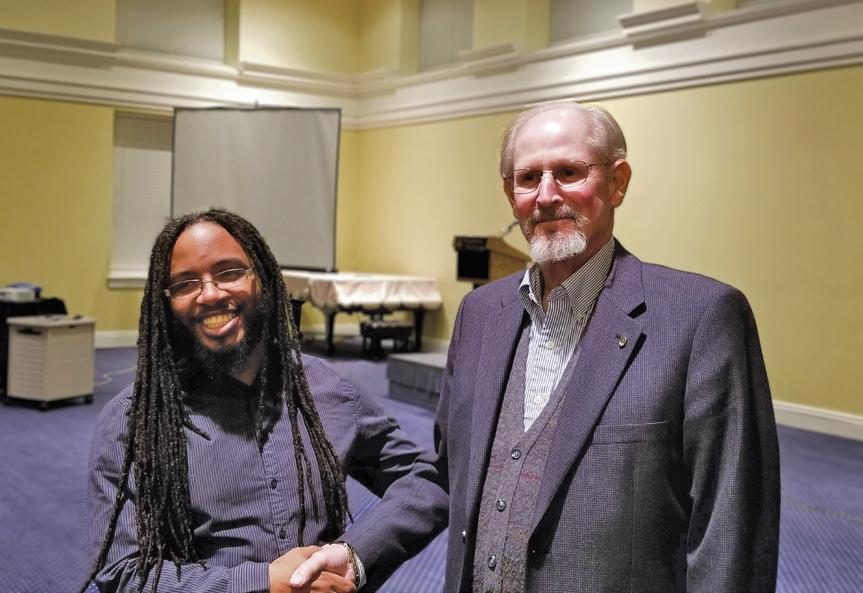
Philosophy: Dr. Chike Jeffers and Professor Emeritus Russ Jacobs

Political
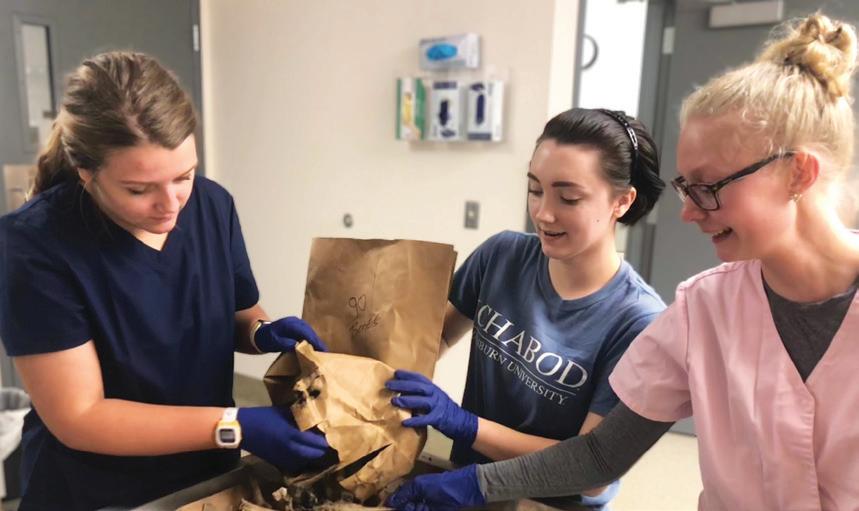
Anthropology:
Sam Calderwood, a philosophy and religious studies double-major, had his paper, “Jesus Barabbas: A Marginal Character,” accepted at the 2020 Society of Biblical Literature Rocky Mountain Regional Meeting. Dr. Chike Jeffers presented “What Counts as a Collective Gift? Culture and Value in Du Bois’ The Gift of Black Folk” at the inaugural Jacobs Lecture, established by emeritus philosophy faculty member Russ Jacobs upon his retirement. (See picture, left.)
Professor Brian Thomas and physics major Cody Ratterman had their paper accepted for publication in Physical Review Research Jacob Oberle presented his poster on ozone depletion as part of the American Geophysical Union’s student Virtual Poster Showcase in October 2019. Student Matthew Christman received K-INBRE awards for the 2019-2020 year, as well as the K-INBRE Star Trainee Award, for work in the Biophotonics Lab with Assistant Professor Vincent Rossi. Majors Matthew Christman and Bijaya Basnet each presented research at the 2020 K-INBRE Annual Symposium and physics major Price Kramer also received the K-INBRE Star Trainee Award. The Physics Department is proud to note that from fall 2019 to fall 2020, the number of department majors nearly doubled.
During the last year, the Political Science Department placed a record number of students in internships, with 40 students interning in the Legislature, Governor’s office, Topeka Mayor’s office, or political campaigns. (See article, p. 8.) Five students travelled to London to study and observe the December 2019 British Parliamentary General Election campaign accompanied by Adjunct Clark Duffy, and twenty students went to Cuba with Associate Professor Linsey Moddelmog in March 2020. Professor and Chair Bob Beatty hosted a live TV Town Hall on the coronavirus in April 2020 and attended the Vice Presidential debate in October. (See picture, left.)
In fall 2019, Lecturer Angela Duncan took students to the Association for Behavioral and Cognitive Therapies conference. Graduate students Bethany McKnight, Rachel Ledbetter, and Makenzie Dunn presented their poster, as did undergraduates Regan Braun and McKenna Ward. Multiple graduate and undergrad students collaborated for a total of seven presentations at the 38th Annual Meeting of the Association for Psychological and Educational Research in Kansas conference during fall 2019. The department has partnered with the Washburn Athletic Department to provide mental health services and psychoeducation to student athletes, including mental health screenings each fall and expanded psychological services.
The Sociology and Anthropology Department is saddened by the loss of Associate Professor Cheryl Childers as well as Associate Professor Emeritus Terry Booth in 2020. Congratulations to Assistant Professor Jason Miller, who brought the Hostile Terrain 94 (HT94) participatory art project to Washburn. (See article, p. 12.) Associate Professor Alexandra Klales was the editor of the book Sex Estimation of the Human Skeleton: History, Methods, and Emerging Techniques. The department welcomes new Lecturer Alex Myers Associate Professor Sangyoub Park and his students continue to support the local community through the annual diaper drive and 1,000 Origami Crane Project.
The Theatre Department is excited to announce they have a new proscenium curtain thanks to the Washburn Women’s Venture Fund, and it’s WU Blue! The Washburn Theatre recently completed their first production of 2020, She Kills Monsters by Qui Nguyen, which forced them to answer the question: how do you stage 7 fight scenes and stay 6 feet apart? Lecturer Ted Shonka, who directed, figured out that challenge and many others. The production was live-streamed, a first for the department. The second show of the year was Mr. Marmalade by Noah Haidle, directed by senior Isabella MartinezHaskins and designed by students.
